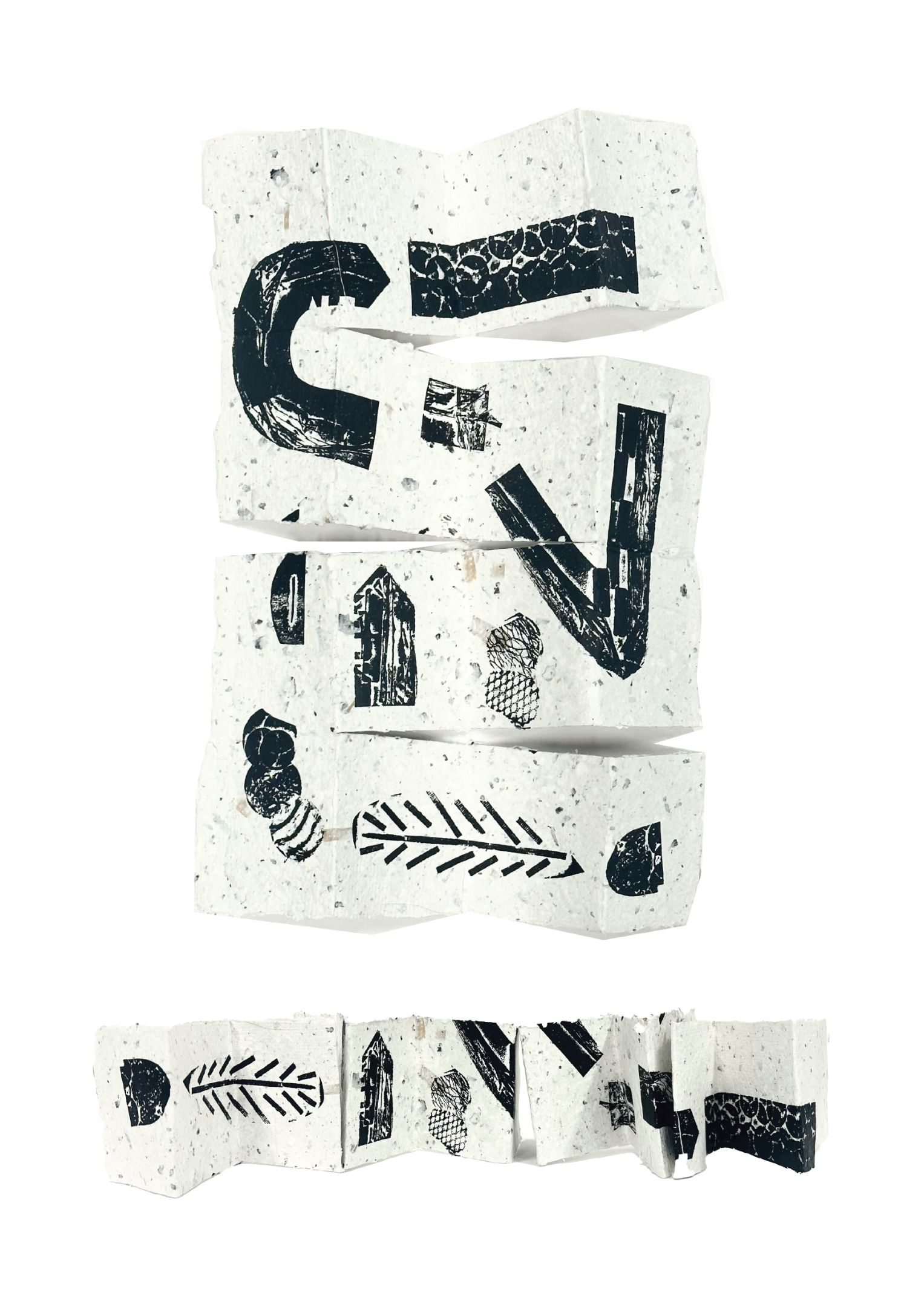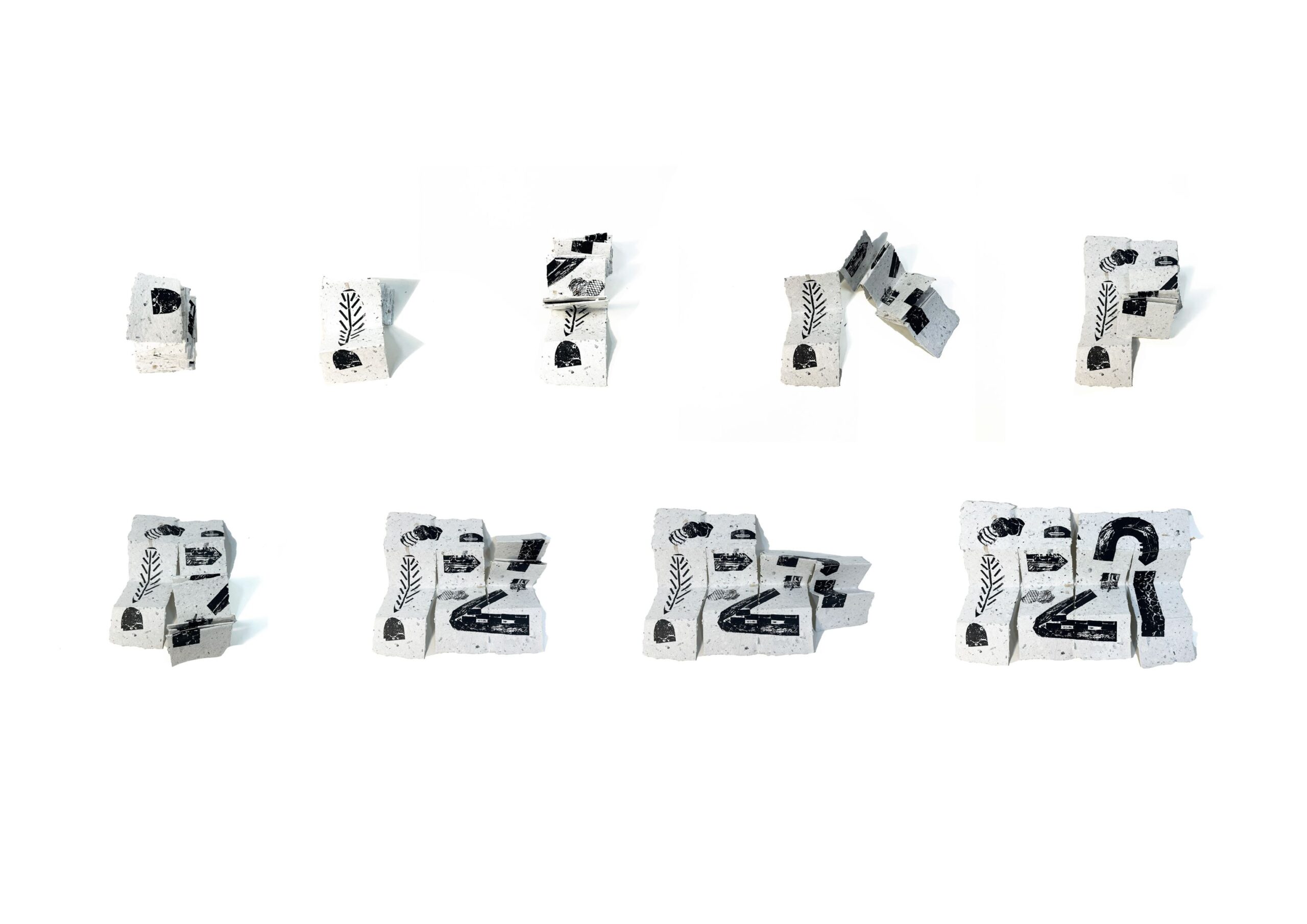
Ms. Napatt Piyawongwatthana



Abstract :
At Mahidol University International College (MUIC), the Traditional Techniques Studio classes which focus on traditional techniques and methods relating to printmaking and illustration creation. The studio class emphasizes on developing skills related to the hand-on process of making images and forms while deepening an understanding of how mediums and techniques are related to the expression of content. As a result, the process causes wasteful material, especially printing papers. Therefore this study aims to create, make, recycled paper from students’ printing paper wastes mentioned above and reuse them in a new printmaking work. By creating new printing paper sheets (recycled) and utilizing them for another printing project, demonstrate attention to details of the investigator and also showcase the innovative solution bringing a sustainability approach to studio teaching and learning environment. The new series of printmaking works were created under the theme and titled “This Print Used to Be Prints.” The making process of the recycled papers and the making of the works are shown in Image 1-3 below (Image 1: The process of making paper pulp and recycled paper, Image 2: Outcomes of recycled printing paper, and Image 3: The experiment with printmaking processes and the possibilities in use for developing products). In conclusion, the students’ printmaking paper wastes from the studio classes can be reduced. This not only helps address and embed the sustainability practice to students in the studio teaching and learning environment, but also trains them to pay attention to details of our surroundings and engage in making improvements creatively for the betterment of themself and their professional future working processes and spaces.
Objectives :
- To reduce studio printing paper wastes by recycling them through the making of handmade paper.
- To discover the possibility of using recycled handmade paper in various printmaking techniques
- To foster sustainable printing practices in studio teaching and learning environments for students and enhance their awareness of environmental consciousness in creative ways.
Conceptual Framework :
Conceptual Framework
The project is developed by using a framework of “Double Diamond” created by the design council (The Design Council, 2007) which consists of four steps including; 1. Discover, 2. Define, 3. Develop, and 4. Deliver (The Design Council, 2007) as described here: First step is “Discover.” This step focuses on the experiment of using different types of printing paper that were left in the studio teaching and learning classes to create paper pulp. Then, the investigator conducted an experiment using recycled handmade paper in different printmaking processes. The second step is “Define.” In this step three categories that are most frequently left in the studio include; monoprint, collagraph intaglio, and kitchen lithography to make paper pulp. The reasons to select these three techniques are as follows; 1. Monoprinting enables students to experiment, leading to occasional errors that are valuable learning experiences before choosing their final works. 2. The Collagraph Intaglio printing process is intricate and delicate, making it prone to difficulties and the appearance of marks if students fail to follow the steps precisely. And 3. Kitchen lithography involves a sophisticated preparation process, enabling the creation of intricate marks while ensuring ink is evenly spread across the entire space.
The third step is “Develop.” This step emphasizes using completed sheets of recycled printing paper to experiment on three main processes in printmaking which are relief, intaglio, and planographic (surface) processes. In our pursuit of sustainable practices and the utilization of recycled studio waste, we have selected non-toxic print techniques for our experiment. These include Monoprint (one-of-a-kind print), Kitchen Lithograph (an adapted lithograph using kitchen materials), Collagraph Intaglio, and Relief (collagraph not only produce stunning prints but also contribute to our environmental responsibility, as they allow us to use recycled materials to create blocks. In the intaglio process, the ink remains in the incised areas, while in the relief process, the ink remains on the surfaces or rising areas).
“Deliver” is the last step. In this step, the most successful prints were selected to experiment for seeking possibilities to develop in design products.
Process / Methodology :
The design process began with materials collected, focusing on old prints that students left behind in the Traditional Techniques Studio class. Three different types of print produced by Kitchen Lithograph, Woodcut, and Collagraph were chosen.
When materials, which are prints, containers with clean water, tablecloths, sponge clothes mold, and deckle, were prepared, the next step was making paper pulp. It began with tearing prints into small pieces and putting them in the container. Then, water was added all over the paper to soak and soften it. After soaking for 12 hours to soften, softer pieces of paper were blended into a delicate texture, and they turned into pulp.
Later, the paper pulp was added to another container with clean water, spreading it to float all over the bath. Then, using the mold and deckle, one empty frame and one mesh frame are attached. Stick these two frames together, put them into the bath, and scoop the pulp into the container. Shake the mold and deckle gently to make the pulp smoother and thicker. After lifting the mold and deckle from the pulp bath, use a sponge cloth to press over to remove the water and flatten the paper. Then, place the paper mold onto the tablecloth and leave it to dry.
Image 1: The process of making paper pulp and recycled paper
Image 2: Outcomes of recycled printing paper
| No | Paper | Type | Strength | Weakness |
| 1 | Recycled paper from Monoprint Old print: Colorful monoprint printed on normal A4 paper |
Thin and lightweight like the original paper Paper got colorful textures from the old prints |
|
|
| 2 | Recycled paper from Collagraph Intaglio
Old print: |
Heavyweight
Paper got grayish tone and masking tape textures from the old prints |
|
|
| 3 | Recycled paper from Kitchen Lithograph
2 colors; black and red or green of lithograph printed on 200 gram paper |
Heavyweight
Paper got textures and colors from the old prints |
|
|
After the paper was completely dried, it was used as printing paper in four different techniques: monoprint (one-of-a-kind print), Kitchen lithograph, and collagraph (both intaglio and relief) and develop to zine
Image 3: The experiment with printmaking processes
Techniques and Materials :
Work 1: Monoprint on Monoprints
Technique: Monoprint on recycled monoprinting paper
Monoprint is a one-of-a-kind print, also known as a unique print which can be printed only once unlike other printmaking processes. Once the plastic sheet is inked, various types of recycled materials are placed over. The artistic processes and principles of arrangement were added. Then, the plate is placed on the printing press and covered with thin paper. When the plate passed through the hard pressure of the printing press. Textures of recycled materials and ink transfer to paper. After the print completely dried. It was taken to experiment to create 8 pages of zine
Work 2: Collagraph on Collagraphs
Technique: Collagraph relief on recycled collagraph intaglio paper
Collagraph relief is the process that combines collage technique and printmaking process. The collage is used for creating blocks. The process begins with collecting recycled material that was left in the Traditional Techniques studio class. They were selected to arrange the composition and add artistic applicants to create value and depth, then glued them on cardboard. After waiting until the glue completely dried, the plates were taken to press in order to make the materials stick tightly and have a flatter surface. Next, the block was inked. Ink would remain on rising areas or surfaces. Smoother surfaces or textures are shown as darker whereas rougher surfaces present lighter values. After the print dried, it was developed to 16 pages of Zine.
Result / Conclusion :
Conclusion
According to the objective the results were analyzed by SWOT Analysis shown below.
| Strengths | Weaknesses | Opportunities | Threats | |
| 1. To reduce studio waste, recycling prints into recycled handmade paper. | – Minimize studio waste
– Expand the variety of printing paper available to use in classroom – Save on printing paper costs. |
– Precisely controlling recycled paper’s physical properties and thickness can be a significant challenge. | – Provide students with opportunities to work with different types of paper. | – In the studio, waste can still be created in the printing process. |
| 2. To discover the possibility of using recycled handmade paper in various printmaking techniques | – Recycled paper can be utilized in all printmaking processes: Relief, Intaglio, and planographic.
– It is possible to create an emboss and deboss effect in print like a normal sheet. – Offer prints with unique textures. |
– There are a few limitations associated with using paper in specific techniques.
– Handmade paper has lower quality in term of strength compared to standard paper sheets – Some recycled printing paper creates strong textures that distract the design |
– Enable to use and explore various types of paper in practice | There are some restrictions, and certain paper types can only be used for practice. |
| 3. To foster sustainable printing practices in studio teaching and learning environments for students and enhance awareness of environmental consciousness in creative ways. | – Possibility of using these papers in Traditional Techniques Studio class .
– Allow students to recycle and reuse class waste to experiment through printmaking techniques |
– The use of materials for adapted printmaking has certain restrictions. | – Encourage the use of diverse printing paper in practices.
– Raising students’ knowledge of environmental issues. |
– The adapted printmaking methods can only offer a fundamental insight. It is unable to be completely understand traditional printmaking techniques |
To reply to the objective, recycled prints left at the studio are a great way to reduce studio waste. The experiments on using recycled printing paper can address sustainability approaches and allow students to explore varieties of paper used in teaching and learning in Traditional Techniques Studio class. The experiments also proved that recycled paper can be used in all printmaking processes. However, It is crucial to select the proper paper for specific processes. Heavyweight paper like the recycled paper from collagraph and lithograph are practical choices for every technique while lightweight has some limitations. Additionally, The prints on recycled paper can be developed into various products. On a final note, completely eliminating waste in the printing process may be challenging; embracing conscious practices and constantly exploring ways to minimize and recycle waste can have a beneficial impact and contribute to sustainable processes for students, training them to pay attention to details and our surroundings for the betterment of their professional future working spaces.
References :
- Fick, B. and Grabowski, B. (2016) Printmaking. A Complete Guide to Materials & Process. rev. Ed. London: Laurence King.
- Paperslurry. Here’s How to Make Handmade Paper from Recycled Materials. (n.d.). Retrieved March 22, 2024 from: https://paperslurry.com/blog/2014/05/19/how-to-make-handmade-paper-from-recycled-materials
- Hughes, D.A. and Vernon-Morris, H. (2023) The printmaking bible: The Complete Guide to materials and Techniques. Kent, U.K.: Search Press.
- Nontoxic Printmaking. (2014, May 14) Non toxic printmaking. Retrieved March 22, 2024 from: https://nontoxic-printmaking.co.nz/non-toxic-printmaking/
- Safer Painting (2023, August 27). Art+Science. Retrieved April 2, 2024 from: https://saferpainting.com/art-safety-i/
- Rob Hodgson Illustrator and Author. (n.d.) Paper Pulp Experiments. Retrieved April 11, 2024, from https://www.robhodgson.com/#/paper-pulp/